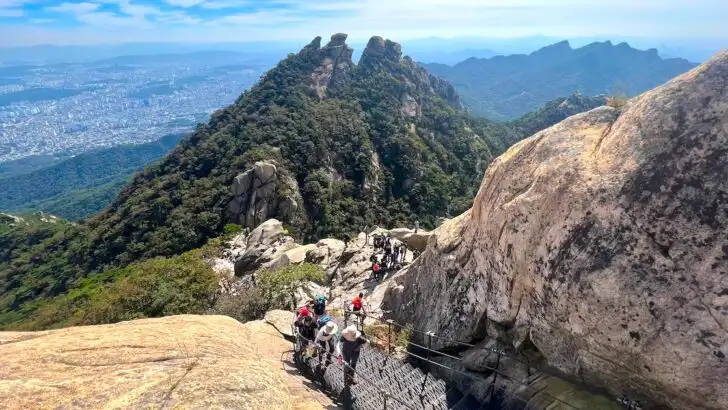Putting together my South Korea itinerary, I was the most excited I’d been in months.
It’s a country that has always fascinated me, so after months of consuming K-Pop and Korean food in preparation, I was itching to explore its cities, islands, national parks and world-famous cuisine.
The only thing is, every South Korea trip itinerary I came across seemed to be a replica of the previous.
I wondered out loud, “Why are people only visiting Seoul, Busan and Jeju?”
I wanted to explore deeper: mountains, temples, fishing towns and destinations that Koreans visit for their holidays.
In the following post, I’ll give you the chance to steal my two-week South Korea itinerary, which covers destinations including Seoul, Seoraksan National Park, Sokcho, Busan, Jirisan, Yeosu and Jeju.
My hope is that you will leave feeling inspired and well-prepared for your itinerary in South Korea, whether you stick to the most popular route or explore off the beaten track.
Disclosure: This post includes affiliate links. If you decide to click through and make a qualifying purchase, I will receive a small commission at no extra cost to you – thanks for your support.
QUICK INFORMATION
Best time to visit: March to May; October to November
Must-haves: T Money and SIM card
Don’t miss these experiences…
1. Gyeongbokgung Palace (including hanbok rental!) 🇰🇷
2. Seoul foodie tour 🍜
3. Jeju south and west highlights tour 🏝️
What is South Korea Known For?
More and more people are becoming interested in travelling to South Korea.
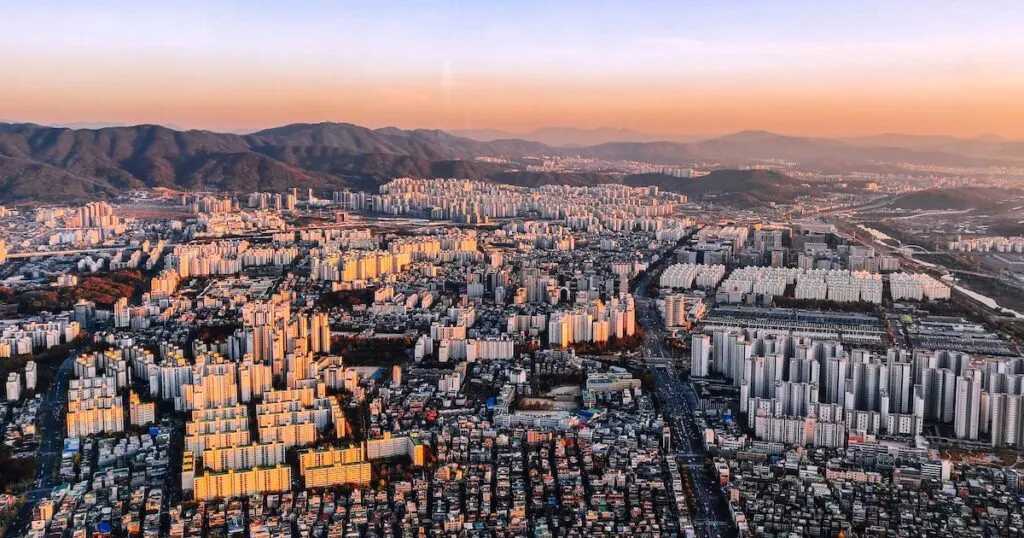
Perhaps you watched a Korean TV show such as Squid Games or Single’s Inferno (both on Netflix) or a popular K-drama.
Perhaps your friend introduced you to the K-pop music genre or Korean skincare products.
You may know a little about Korea’s history: Japanese occupation, the Korean War or the collective of female free divers in Jeju Island, the Haenyeo.

From Seoul, you can easily visit the Korean Demilitarised Zone (DMZ), a weapons-free area between North and South Korea, and one of the most heavily militarised zones in the world.
Seoul also has many villages featuring traditional hanok houses with wooden frames and tiled roofs.
A popular activity is renting a hanbok, the traditional Korean outfit, and visiting the city’s historic royal palaces.
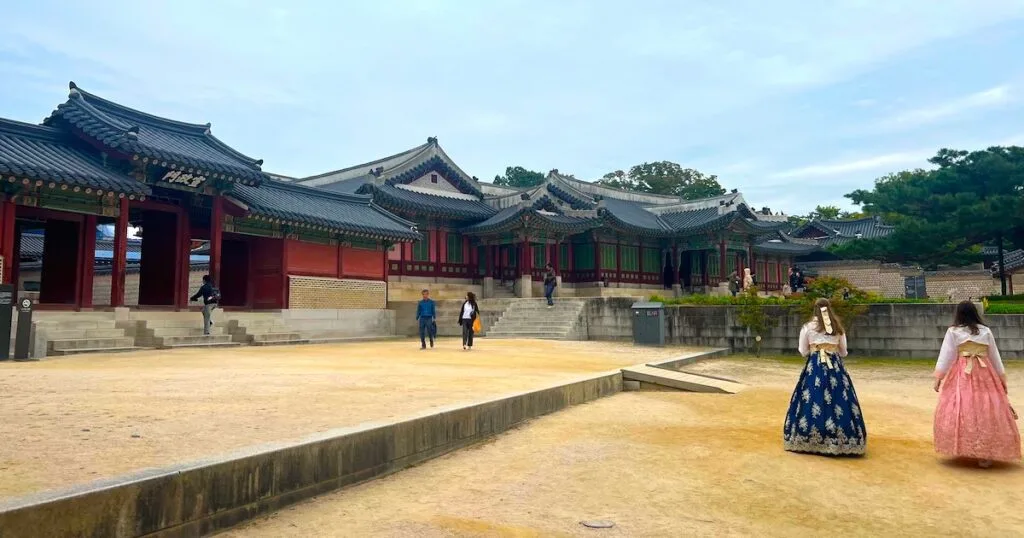
I must say that South Korea is hugely underrated for hiking too.
It has several huge mountain ranges, with many important temples and day hikes or multi-day trails.
There is a huge hiking culture in Korea, with many locals taking the subway to the hikes in Seoul.

And how could I leave out the Korean cuisine, which uses kimchi (a spicy fermented cabbage) as a staple?
On my South Korea itinerary, I ate copious amounts of Korean barbecue, tteokbokki, gimbap, bibimbap and ox bone soup.
In short, South Korea is known for:
- Popular culture such as K-pop, K-dramas, and TV shows like Squid Games.
- Food such as kimchi, gimbap and Korean barbecue.
- Mountains and national parks.
- Large cities with good public transport.
- Traditional architecture, palaces and the hanbok.
- Beauty and skincare treatments.
My Experience Visiting South Korea
I spent one month in South Korea. For the first two weeks, I jumped into a fast-paced itinerary spanning the whole length of the country.
For the final two weeks, I rested on Jeju Island to get some writing done.
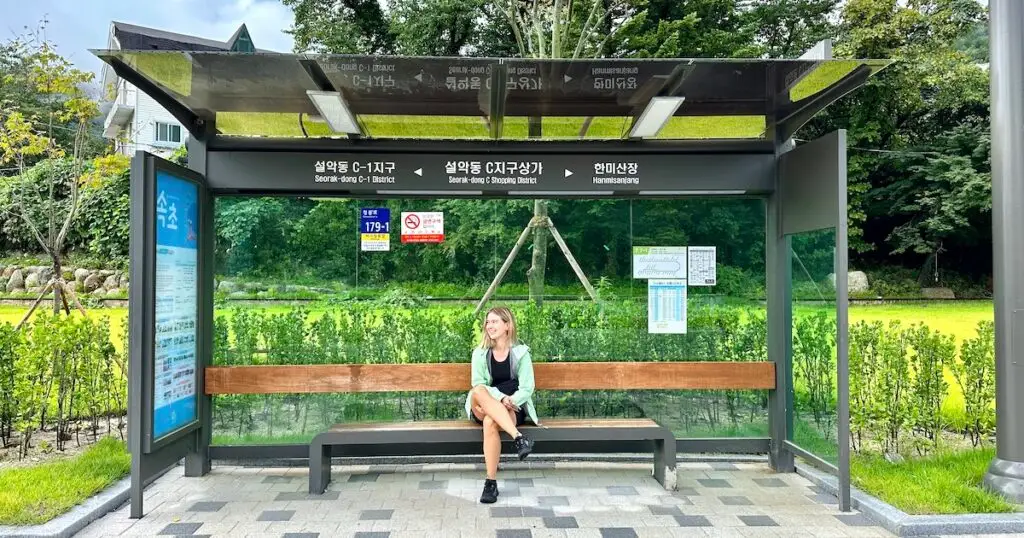
I started and ended my South Korea itinerary in Seoul, where I spent most of my time hiking, visiting royal palaces and eating (of course…).

After my first time in Seoul, I took the bus east to Sokcho and Seoraksan National Park.
I was especially keen to hike to the top of the Ulsanbawi Rock trail, one of the most dramatic pieces of scenery in the country.
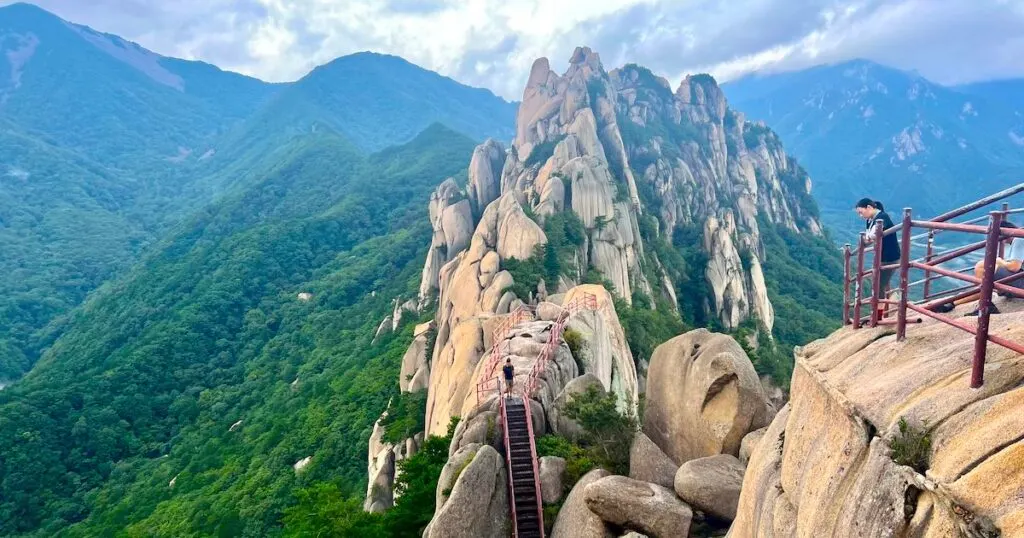
Ulsanbawi Rock
After a quick stop in Busan for some much-needed beach time, I visited Gurye to do a three-day hike through Jirisan National Park.
The Jirisan Edge trail is a bucket-list and highly spiritual experience for most Koreans.
Unfortunately, an extreme heatwave forced me to cancel the hike. Instead, I explored some of the most important Buddhist temples in the country.
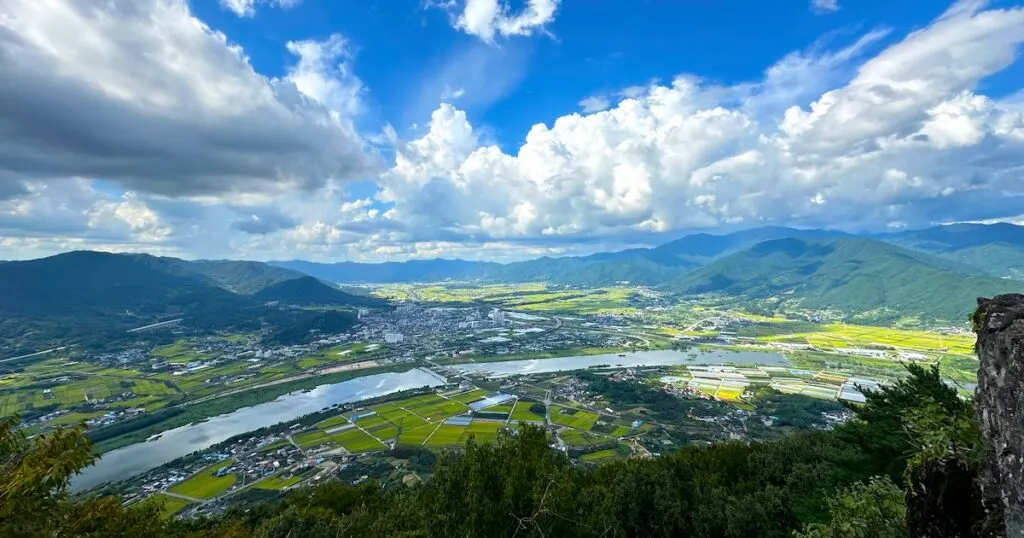
Next, I took the train to Yeosu, a popular holiday location for many South Koreans. It is surrounded by islands with hiking trails and wildlife.
Finally, I rounded up my trip on Jeju Island, the largest island in South Korea.
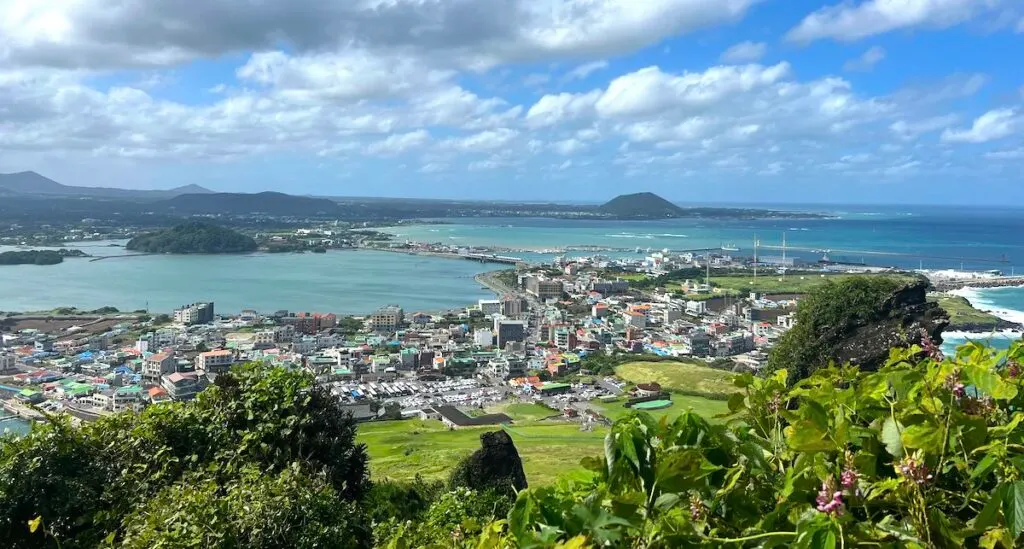
I spent two weeks writing and exploring Jeju: I hiked South Korea’s highest mountain, Mount Hallasan, and visited Seongsan Ilchulbong to learn more about the Haenyeo.
When is the Best Time to Visit South Korea?
Most people will advise you to visit South Korea in March to May or September to October, when the weather is moderate.
This is useful advice: it avoids South Korea’s very cold winter and hot, humid summer.
However, I visited South Korea from September to October and got very unlucky with the weather.
For the first five days, it rained. This was followed by an extreme heatwave, uncharacteristic for the time of year.
Next came a typhoon, which I narrowly missed by flying to Jeju Island.
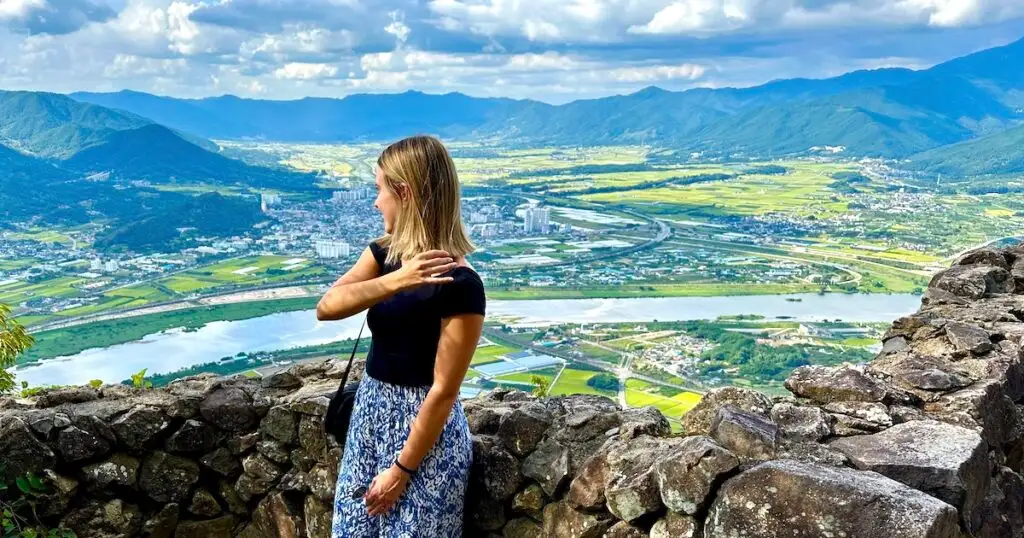
Finally, in the last week of my month-long trip, I was treated to sunshine and moderate temperatures; the leaves in Seoul had just started to turn orange, marking the beginning of autumn.
Typhoon season typically runs from June to November, so I’d say the best time to visit South Korea is actually March to May.
In March and May, it’s springtime, so you won’t get to see the autumn colours. However, you might get to see the cherry blossom season, which is just as exciting.
Four Must-Knows Before Visiting South Korea
There are several things you must know before visiting South Korea.
1. English is not widely spoken in South Korea
Most of the older generation in Korea does not speak English as a second language.
Therefore, I highly recommend learning a few basic phrases and using Google Translate where necessary to communicate with locals.
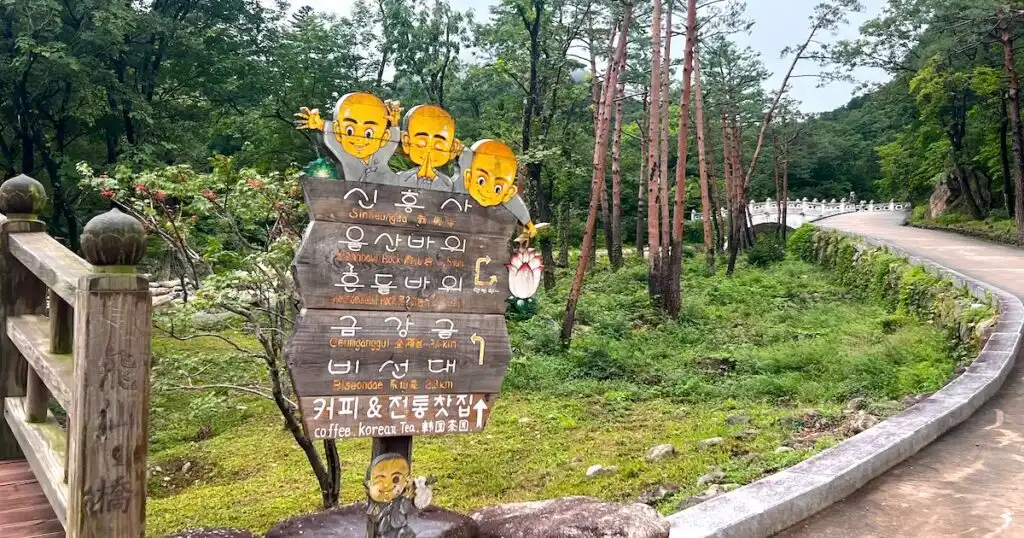
Signposts and food packaging are usually only displayed in Korean. Therefore, I regularly used the image-to-text feature on Google Translate.
2. You can pre-order a transportation card and SIM card
Taxis are quite expensive in South Korea. However, public transport is very affordable and comprehensive.
To pay for public buses, you need a T-Money card, a contactless card that you can top up with money in shops like 7-Eleven. You can also use this card to pay for the subway and at some restaurants.
Some – but not all – buses accept cash in South Korea, so it’s a must-have.
I booked my T-Money package online before flying to Seoul.
This was by far the best decision I made, because the two most important things I needed (a transport card and unlimited internet access) were waiting for me at a stall at the airport.
My 30-day package cost me £35.75, which worked out cheaper than purchasing both items upon arrival. For 15 days, the price is only £27.48.
3. Download some Korean navigation apps
Google Maps does not work in Korea. Instead, you should download NAVER Map or Kakao Maps.
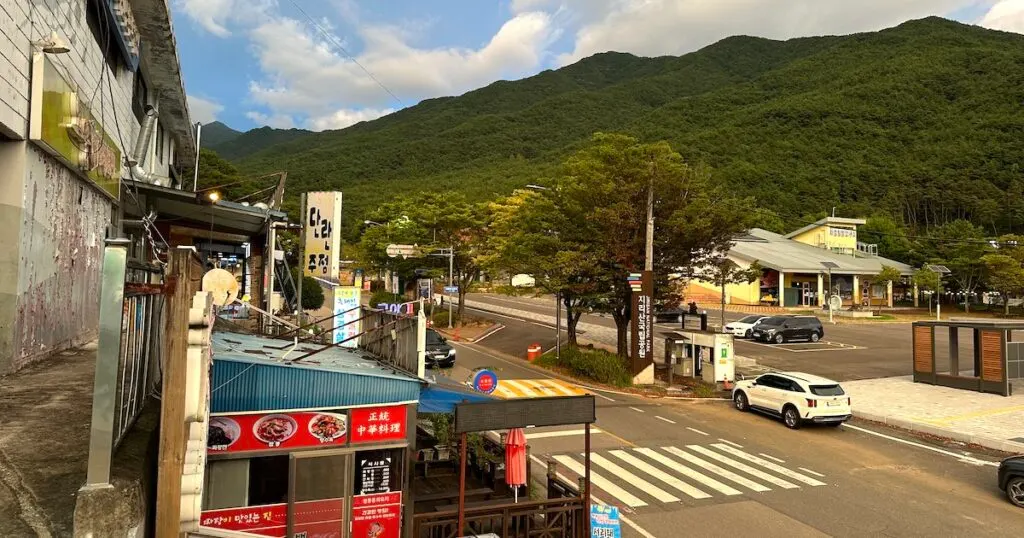
These navigation apps work just like Google Maps, providing directions and public transport routes from point to point.
I tried both apps but ultimately found NAVER Map more intuitive to use than Kakao.
4. Travel with respect for the country and its customs
There are some things that are considered offensive in South Korea that might not think twice about doing at home:
- PDA (public displays of affection) are frowned upon; hand-holding is fine.
- Tipping is sometimes considered rude; it can be interpreted as suggesting that the worker or establishment needs charity.
- Wearing shoes indoors is offensive. It’s best to take your shoes off when entering a business (including many restaurants), guesthouse or home.
- Blowing your nose in public is considered rude.
- Spitting and littering are no-nos.
- Wearing revealing clothes and swearing are also frowned upon.
- It’s best practice to accept food when offered; refusing can be seen as impolite and ungrateful.
My Complete 2-Week South Korea Itinerary
1. Seoul
Time needed: 4 days
Highlights: Hiking, royal palaces, food and city views.

I kickstarted my two-week South Korea itinerary in Seoul, the country’s capital.
This huge metropolis has royal palaces, busy shopping districts, the scenic river Han and mountains.
Bit by bit, I explored the city using the subway and bus, starting with some of the city’s best hikes, before visiting the royal palaces, the Namsan cable car and other attractions.
A) Hike Seoul’s highest mountain, Bukhansan
Seoul is a playground for hikers: it has 107 named mountains and countless hiking trails that will take you high above the city.
My main focus was hiking Bukhansan, the highest mountain in Seoul.

Using the Bukhansan Main Route on AllTrails as a guide, I reached the top of the mountain within a couple of hours.
The rocky peak is covered in smooth boulders. The tips of the trees were just turning orange, marking the beginning of autumn.
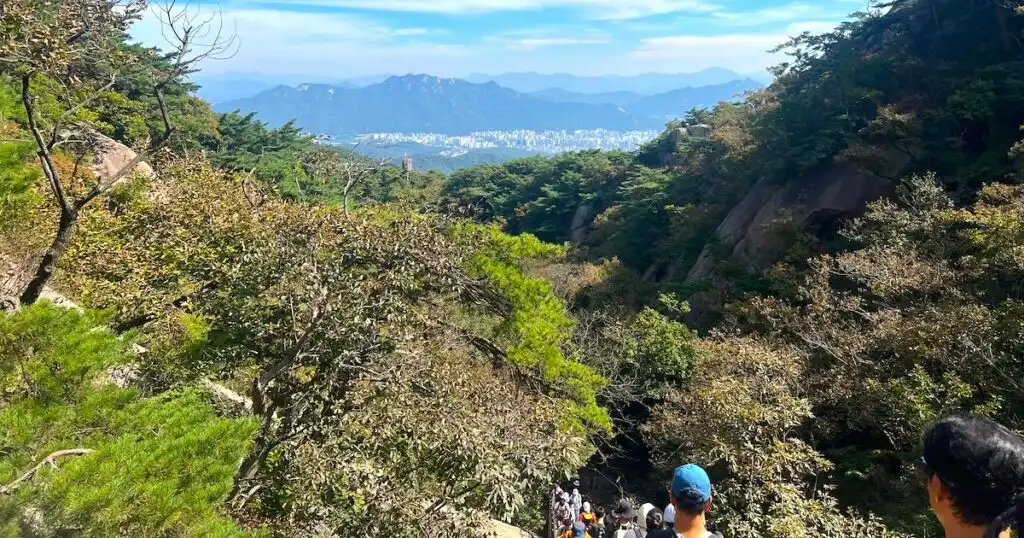

Behind the mountains and forest, Seoul’s skyscrapers sat in blue haze. The views were very worthwhile after climbing 750 metres uphill.
It’s quite a battle to reach the summit; steel railings provide some support on the final section of the trail, which is very steep and requires some upper body strength to hoist yourself uphill.
I visited Bukhansan on a hot, sunny Saturday, so it was predictably busy. If you can, visit the peak on a weekday to avoid the crowds.

How to get there: Subway Line 3 to Gupabal Station; walk uphill or hail a taxi to the trail entrance (as marked on AllTrails).
B) Visit Namsan Mountain Park and Seoul Tower
If you don’t want to hike, the best views in Seoul are from Namsan Mountain Park, where an effort-free cable car operates from the Namsan car park.
Overlooking a green park, the city and the distant Bukhansan mountain range, the cable car slowly climbs up to the 270-metre-high peak.
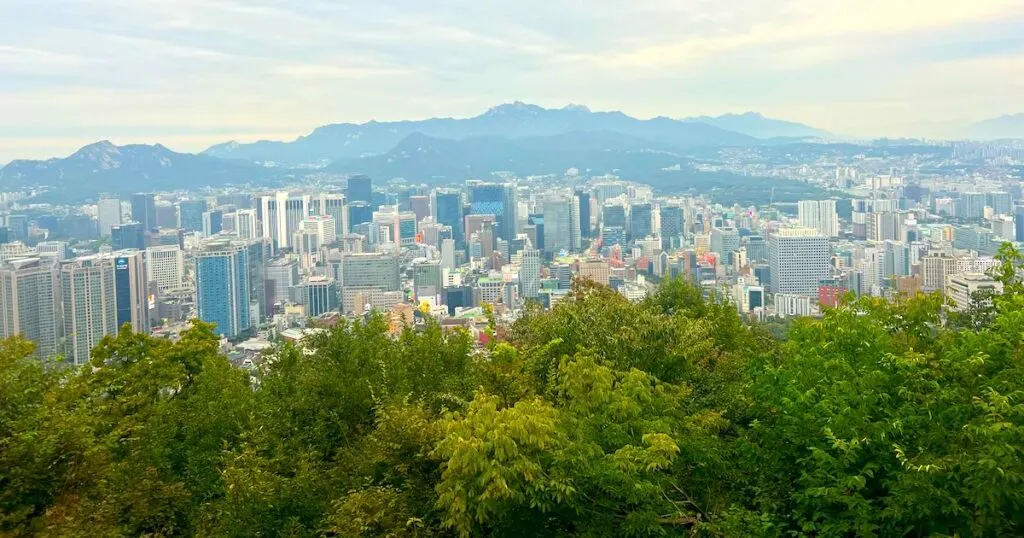
The cable car deposited me at a large viewpoint with benches, restaurants, shops and access to the Seoul Tower (for an additional fee), which has a 360-degree viewing platform.
Entry to the observatory costs 24,363 won (£11.80) per person; you can book your North Seoul observatory ticket online.
The Namsan cable car tickets costs 13,500 won (£7.20) for a round trip. You can book this in person when you arrive at the cable car station.

If you prefer, you can hike to the Seoul Tower instead.
The most popular but longest hike is the Namsan Loop (five miles – approximately 2.5 hours), which has 990 feet of elevation gain.
Hiking directly up and down the stairs from Myeongdong Station takes just over an hour.
How to get there: I took the bus to the Namsan Oreumi Elevator. You can also take the subway Line 4 to Myeongdong Station and walk from there.
C) Visit Seoul’s royal palaces
Seoul has five royal palaces, all built during the Joseon Dynasty.
These are your window into the history of Seoul, where royals resided in vast palace grounds.
This was before the Japanese wreaked destruction on the palaces during the Japanese occupation. After this, the traditional architecture was carefully restored over a long period of time.
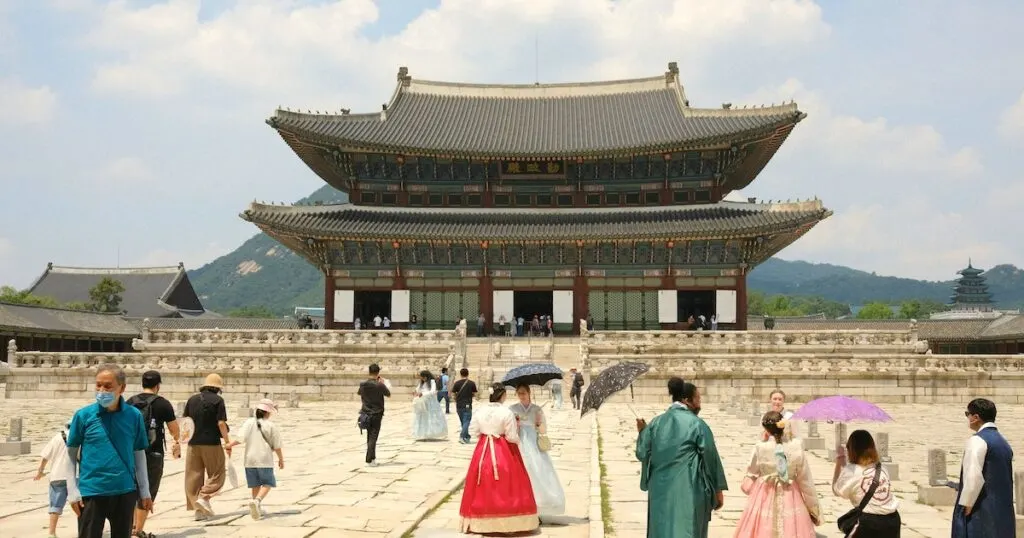
Gyeongbokgung Palace
The five royal palaces include:
- Gyeongbokgung: The largest royal palace in Seoul, built in 1395 and carefully restored after its destruction during Japanese occupation.
- Changdeokgung: The secondary royal palace, built in 1405 and home to a Secret Garden.
- Changgyeonggung: A peaceful palace for royal retirees.
- Deoksugung: A temporary residence during the Joseon Dynasty.
- Gyeonghuigung: Another temporary residence used by royals during restorations.
Most people choose to visit the largest and grandest palace, Gyeongbokgung Palace.
Built in 1395, Gyeongbokgung Palace was the main target for the Japanese as it was the centre of the Joseon Dynasty.
One of the most popular tourist activities is to rent a Hanbok, the traditional Korean wear, while visiting Gyeongbokgung Palace.
You can book your Hanbok rental with Gyeongbokgung Palace Entry online; I recommend booking in advance because this is a very popular activity that almost always sells out.
Gyeongbokgung Palace is next door to Changdeokgung Palace, a smaller palace with a peaceful Secret Garden (separate tickets are required), formerly used for royal parties.
Wanting to avoid the larger crowds at Gyeongbokgung, I visited Changdeokgung and was in awe of the architecture and landscaped gardens.

Changdeokgung Palace
Make sure to check your timings in advance, as free guided tours (in English, Japanese or Chinese) are available at increments throughout the day.
The Changing of the Guard happens at Deoksugung Palace three times per day too.
D) Explore Seoul’s markets and restaurants
Seoul is one of the best places in the country to explore the diverse Korean cuisine. It has many local food markets and restaurants serving typical Korean dishes.
As I discovered throughout my one month in South Korea, there are a few must-try staples in Korea:
- Gimbap/kimbap: Cooked rice and fillings rolled in seaweed.
- Bibimbap: A Korean rice bowl with vegetables, egg and gochujang sauce.
- Tteokbokki: Chewy rice balls in a creamy tomato-based sauce – the ultimate comfort food!
- Korean fried chicken: Chicken fried in batter.
- Bulgogi: Thinly sliced beef or other meats marinated in soy sauce dressing.
- Kimchi fried rice: Spicy fried rice featuring kimchi.
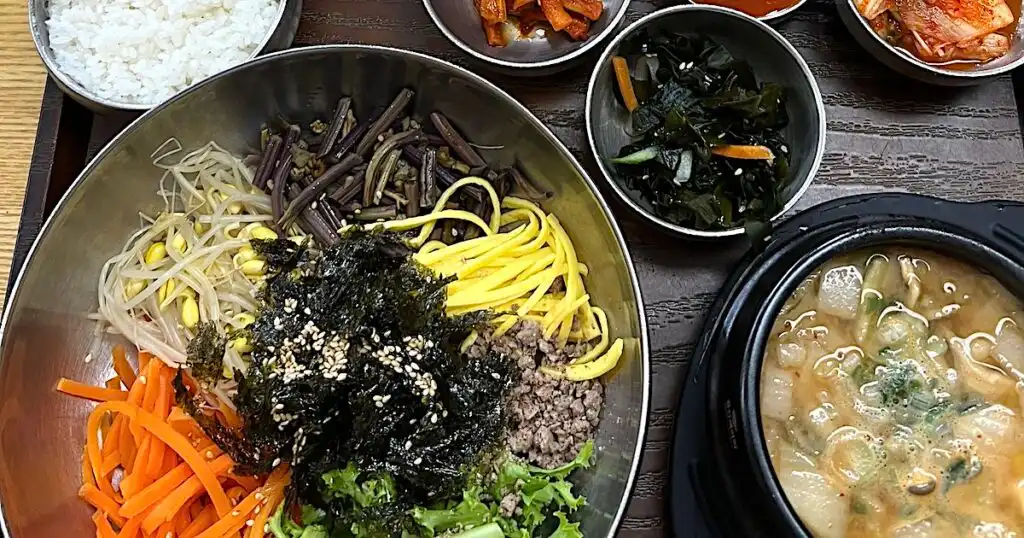
One of many bibimbap bowls I consumed in Korea
My favourite restaurant in Seoul was Flying Chicken in Mapo-gu, open since 2001.
Decorated in US army bunker style, its signature dish is ‘fire chicken’, a spicy, cheesy chicken dish marinated in gochujang sauce.
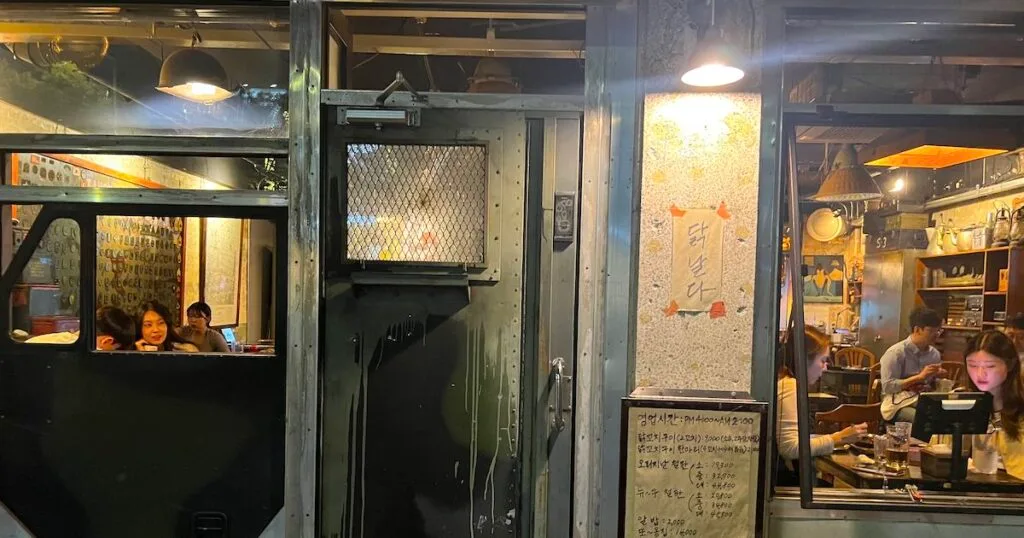
Flying Chicken, Mapo-gu
It was the best meal I had in Seoul – and I found it on Naver Maps, so it’s not so well known with international tourists, but packed with locals.
If you’re keen to explore Seoul’s food markets – as you should be – then Gwangjang Market is the most famous.
Featuring over 5,000 stalls, it is one of the oldest and largest traditional markets in the country.
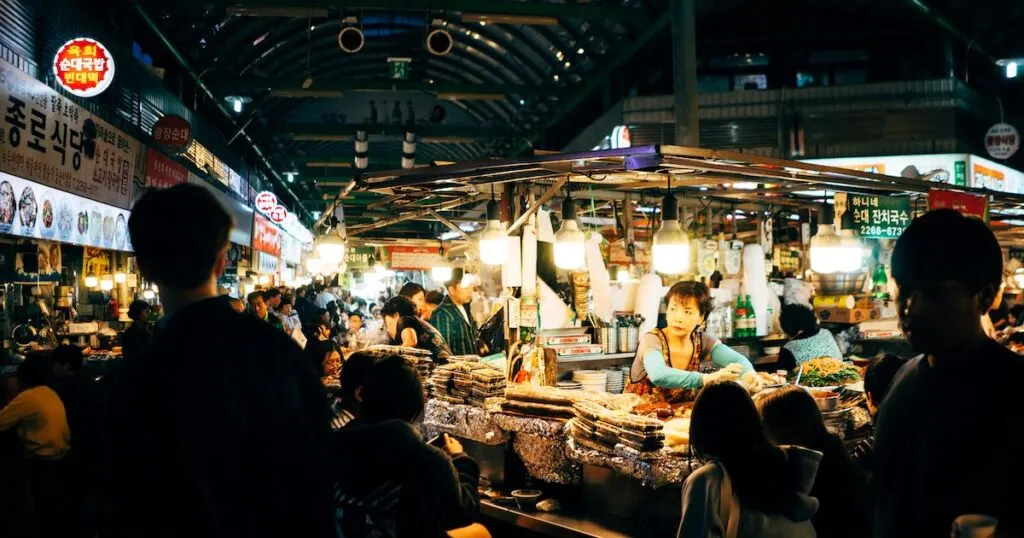
Gwangjang Market
It can be extremely busy, but the food speaks for itself: steaming-hot dumplings, tteokbokki, mung bean pancakes, and Korean fried chicken.
This is one activity where I think it’s absolutely worthwhile taking a tour with a local guide.
They can help you find the best stalls and freshest food, and should also help you get a good price.
You can book a daytime guided foodie walking tour or take the livelier evening slot on a night market tour.
E) Get a South Korean beauty treatment or colour analysis
Seoul is also the best place to get a South Korean beauty treatment.
There are so many beauty treatments available in South Korea – including full-blown plastic surgery – but the most famous are the skincare or colour analysis sessions.
I was a little bit dubious about getting a skincare treatment However, after some consideration, I had a non-invasive treatment at Individuel Geneve, which is aimed at English-speaking foreigners.
I liked the skin analysis, which identified areas of my face prone to wrinkles and blemishes.
I was given a list of K-Beauty products to buy in Olive Young, tailored to skin composition – gold dust!
However, I found the actual treatment quite underwhelming. Later, I had a dermatitis reaction, where my skin turned bright red – not uncommon, I found out through Instagram.
That being said, I’m not particularly interested in cosmetics, and I don’t have an extensive skincare regimen as it is. If you’re already investing in your skincare, you might appreciate it more.
Next time, I would opt for a less intrusive colour and make-up analysis session. These help you find the best colours, makeup, hair and glasses styles to accentuate your natural features.
My mother had one done many years ago, and still raves about it.
To help you find your colour, they use 200+ different drapes. So, next time you go shopping (in South Korea or not), you’ll know exactly which colours to look for.
F) Visit South Korea’s Demilitarised Zone
From Seoul, you can take a tour to South Korea’s Demilitarised Zone.
You can’t visit on your own accord, so you must check the availability of a DMZ tour.
Located next to the border with North Korea, this weapons-free area has views over North Korea and several historic sites, including the 3rd Infiltration Tunnel, where North Korea plotted to invade South Korea.
The tours visit the tunnel, the Dora Observatory overlooking North Korean territory and the Gamaksan Chulleong Suspension Bridge, which was built over a major battlefield for the Korean War.
F) Other places to visit in Seoul
I could go on and on about all the things to do in Seoul, so it’s worthwhile for me to list a few other ideas here.
If any take your fancy, you can add them to your South Korea itinerary…
- Visit Bukchon Hanok Village to see traditional Korean houses called hanok – this can be a busy tourist destination, so be prepared for crowds!
- Explore the famous nightclubs of Hongdae Street, popular with Korean university students.
- Explore Myeong-dong, Seoul’s popular shopping district.
- Stroll or cycle along the Han River.
2. Seoraksan National Park and Sokcho
Time needed: 2 days
Highlights: Hiking, seafood and waterfalls
Many people don’t realise that Seoraksan National Park, an incredible mountain range with 60+ named mountains, is only two and a half hours’ drive away from Seoul.

Better yet, if you don’t have time in your South Korea itinerary to visit for a couple of days, there are day trips from Seoul (the standard Seoraksan day tour or a hiking tour).
If you’re a keen hiker, I recommend that you spend two to three days in Seoraksan like I did.
As I explain in my full Seoraksan National Park hiking guide, I booked my bus from Seoul to Sokcho online.
After arriving in Sokcho, a coastal city famous for its seafood, I then took bus line 7 or 7-1 to my guesthouse, Smile Resort.
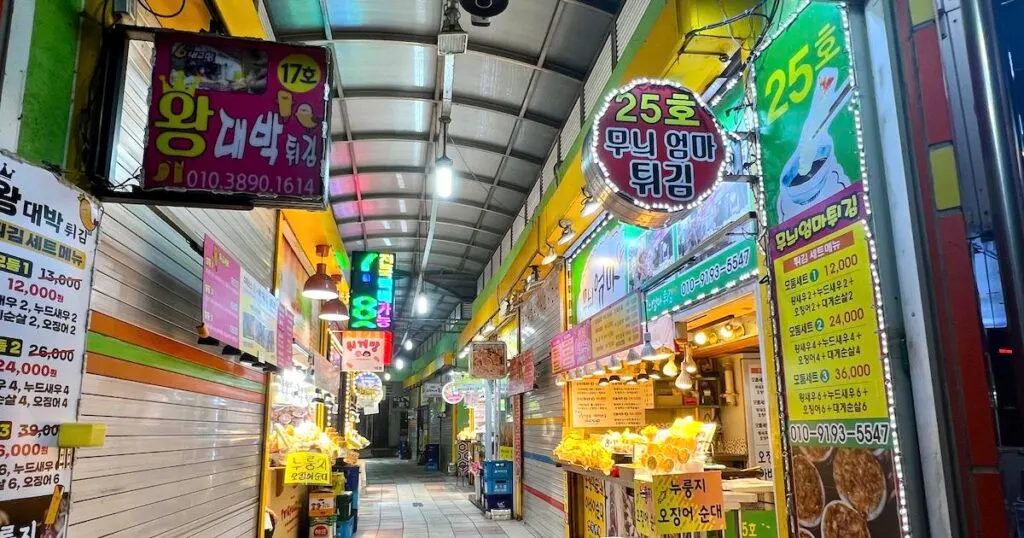
If you can afford it, though, you should stay at Kensington Hotel Seorak, the only hotel at the entrance to the national park. The views are unbeatable.
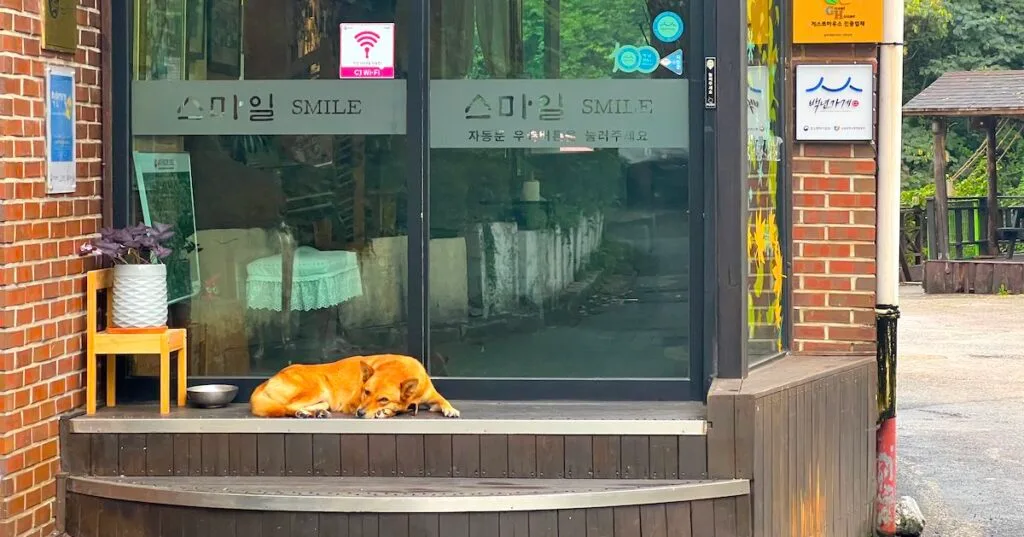
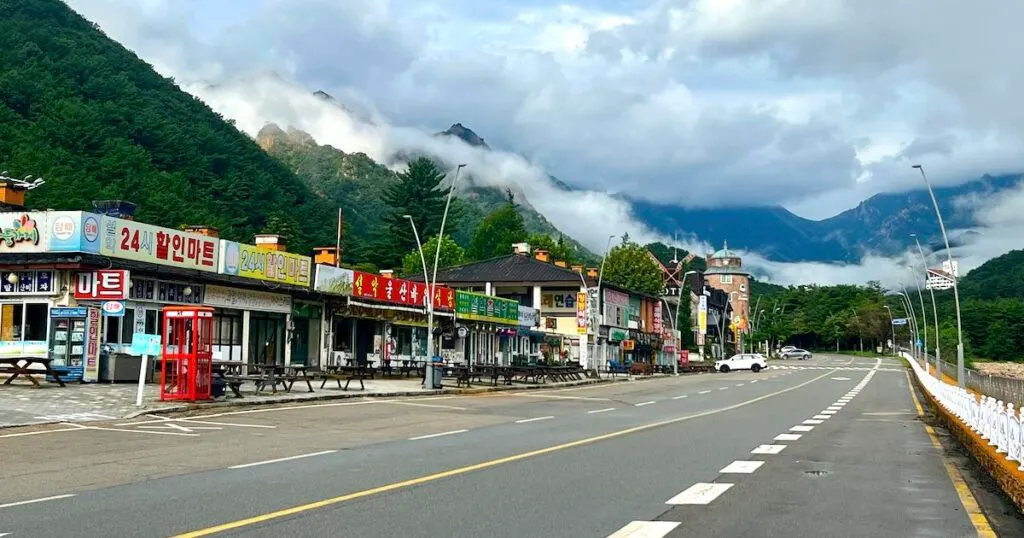
A) Ulsanbawi Rock hike
There are 35 hiking trails in the national park, but my favourite – and the most famous – is Ulsanbawi Rock.
With 4.4 miles and 566 metres to cover, the hike will take you four to five hours.
I started out hiking through a low-hanging mist, but as I emerged onto the final staircase, the green valley revealed itself.
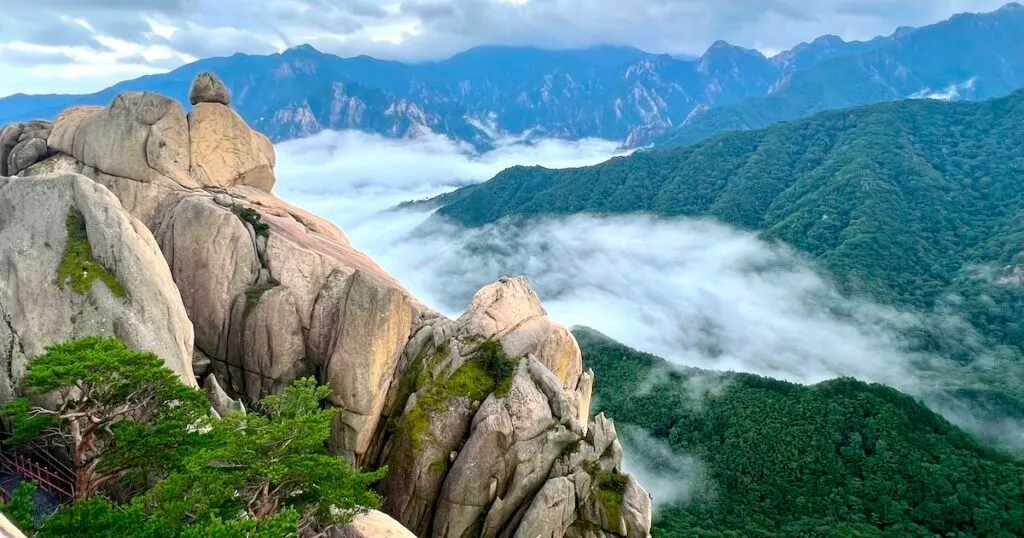

This is a surreal hike with a very unique rock formation at the summit, made up of large granite boulders. There is one small temple halfway up the hike.
B) Biryong Falls and Towangseong Falls Observatory hike
My second hike – a very different one – was to Biryong Falls and the Towangseong Falls Observatory.
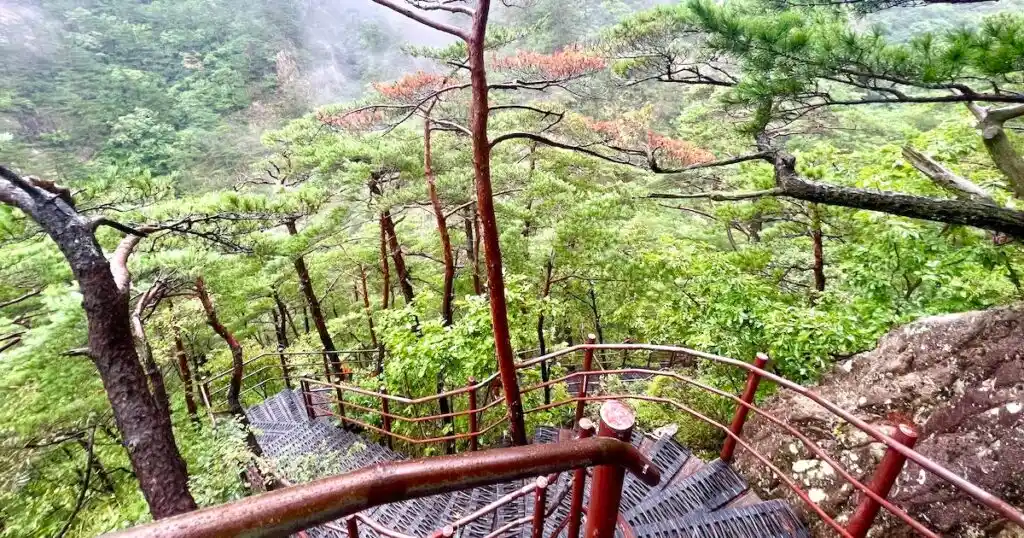
Despite hiking in the rain, the canyon was immensely beautiful – and the staircase to the observatory felt otherworldly, with the rocky peaks hidden behind the clouds.
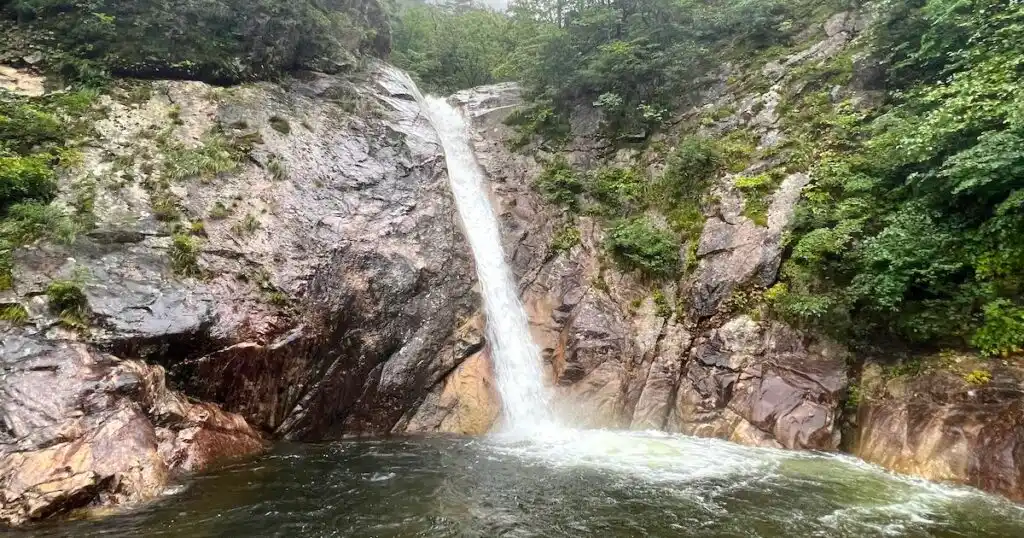
C) Take the cable car to Gwongeumseong Fortress
If you’re not a keen hiker, you still have plenty of reasons to visit Seoraksan National Park.
The Seoraksan cable car will carry you up to Gwongeumseong Fortress on Mount Seorak, 700 metres above sea level.
On the national park’s ground level, there are a couple of temples and plenty of restaurants – my favourite was Dahyang Cafe, where I grabbed my daily coffee and comforting glutinous rice cakes.
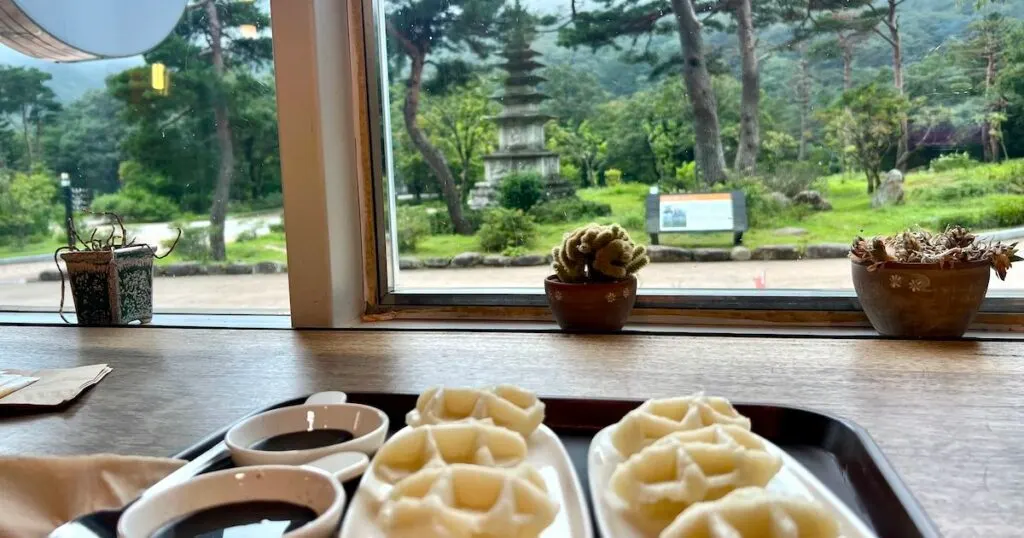
D) Explore Sokcho city
In the evening, I highly recommend that you catch the bus to Sokcho. There are many seafood restaurants at Daiho-ko harbour specialising in raw seafood dishes.
In Sokcho, you can add Jungang Market to your South Korea itinerary. Open since 1980, sells fresh fish and snow crab.

3. Busan
Time needed: 2 days
Highlights: Beaches, seafood markets, watersports.
Busan is a well-known destination on most South Korea itineraries, and it’s easily accessible using the high-speed KTX from Seoul to Busan or a bus from Sokcho.
It wasn’t my favourite place in South Korea, mainly because it’s very busy – and the main tourist attractions, such as the Sky Capsule, are expensive to visit.

However, for beaches and seafood, this seaside city is incredible. The skyscrapers melt into the sandy coastline.
If you do want to see the tourist sites, the Visit Busan pass offers the best value for money. It provides entry to most of the main attractions in Busan within 24 hours – Busan Tower, Busan X the Sky and more.
A) Unwind at Haeundae Beach
Attracted by the prospect of beach time, I stayed in the Haeundae area.
Towered over by glass skyscrapers, the sandy beach is almost 1.5 kilometres long.
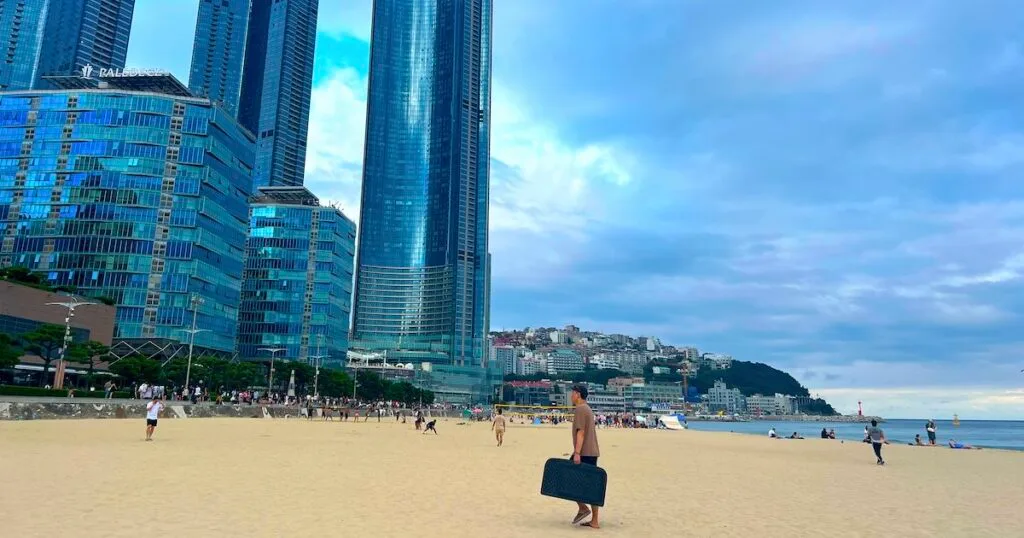
It’s a popular area that’s estimated to receive over 10 million visitors per year. Despite that, I appreciate that there was still plenty of space to swim in the designated swimming zones.
There are also activities like jet‑skiing, parasailing and surfing available at the beach, depending on the time of year.

Most people stroll along the promenade or enjoy the views of the beach and Gwangan Bridge from Busan X The Sky Observatory.
This is the highest observation deck in South Korea – grab your admission ticket here; it’s also included in the Visit Busan pass.

Haeundae Traditional Market
Instead of visiting the observatory, I spent most of my time browsing the Haeundae Traditional Market, open since 1910, and sinking my teeth into street food like tteokbokki.
B) Ride on the Haeundae Blue Line Park Sky Capsule
This Haeundae neighbourhood is also home to the Haeundae Blue Line Park Sky Capsule, one of the most famous attractions in Busan.
Repurposed out of the old Donghae Nambu Railway, the tourist attraction consists of compact, brightly-coloured passenger cubicles that ride between the Mipo and Cheongsapo stations.
They overlook the Busan coast and pine forests.
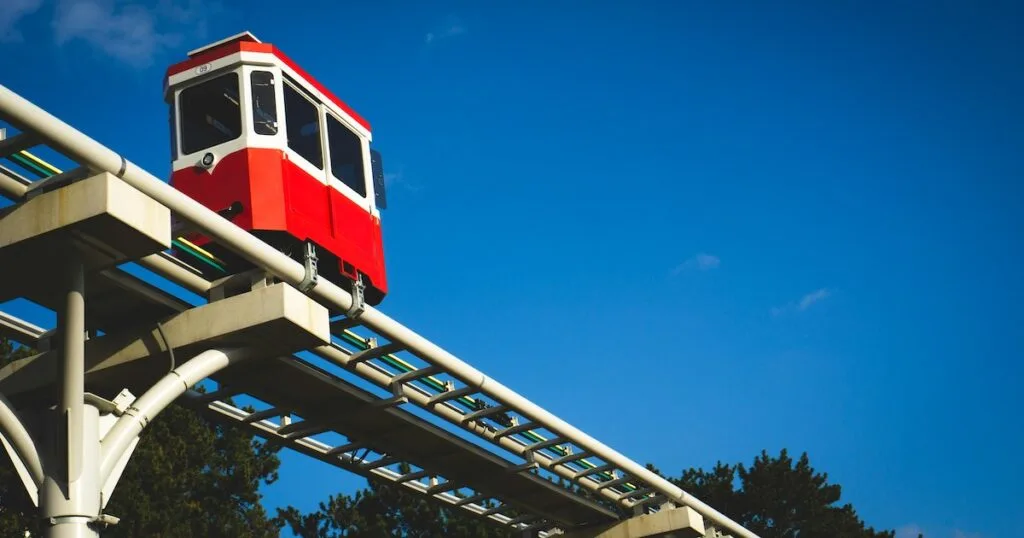
This attraction isn’t included in the Visit Busan pass, so you must book your Sky Capsule train ticket separately.
Alternatively, you can book onto a Sky Capsule and Coastal Wonders tour to pack more into one day; it also visits the glass-floor Oryukdo Skywalk and the Gamcheon Cultural Village – more on that next…
C) Explore the colourful Gamcheon Cultural Village
The Gamcheon Cultural Village is another famous attraction in Busan.
This colourful neighbourhood, built in the 1920s and 30s, has belonged to working-class Korean families and Korean War refugees for many years – so please be respectful of the residents when you’re visiting and taking pictures.
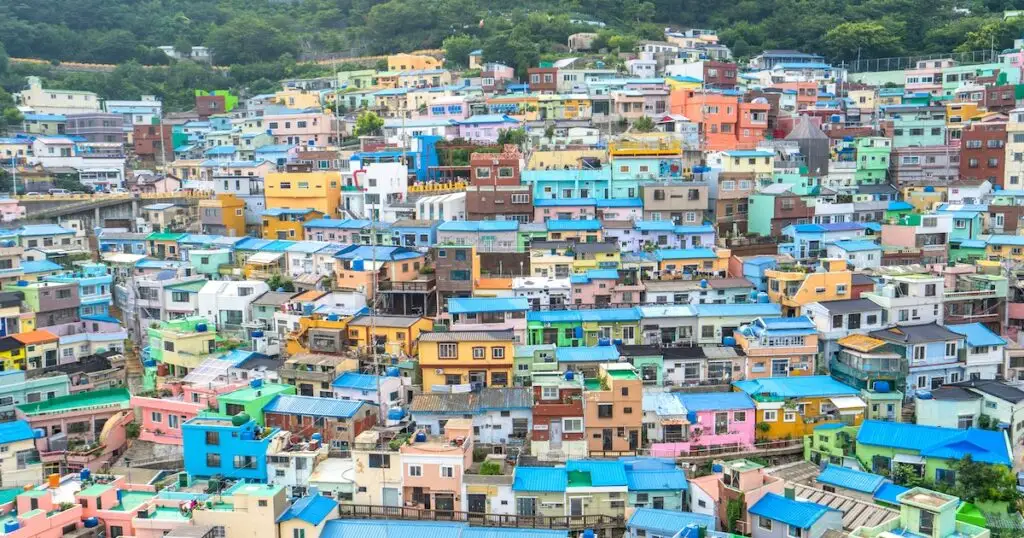
Arranged in a terrace-like structure to ensure residents get an ocean view, the pastel houses are incredibly pretty.
Many shops, art studios, coffee shops and street food stalls are scattered around the alleyways. There is also a Little Museum, with replicas from the neighbourhood’s past.
D) Visit the Busan Tower and Jagalchi Fish Market
Set on a 69-metre hill in Yongdusan Park, the 120-metre-high Busan Tower has one of the best views in Busan.
The observatory has 360° views of the city, including the nearby Jagalchi Fish Market.
You can easily visit both destinations in one fell swoop. Jagalchi Fish Market is the largest fish market in South Korea and a central point in the city, which skyrocketed in popularity after the Korean War.
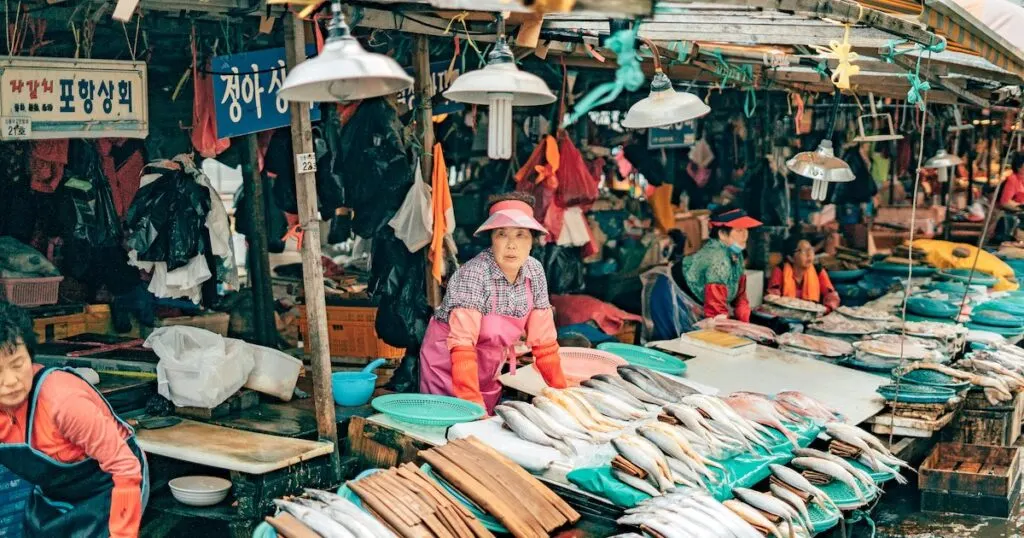
The stalls are usually run by ajummas (married women) who will sell you fresh fish, crabs, octopus and other seafood caught by their husbands.
Some stalls will prepare you dishes like daege (steamed snow crab), hoe (raw fish similar to sashimi) and sannakji (live Octopus).
E) Take a day trip to Gyeongju
Located almost 50 miles north of Busan is Gyeongju, also known as the Three Kingdoms Capital.
A day trip to Gyeongju is a good idea if you’re looking to learn more about South Korea’s complicated history.

The city, now a designated UNESCO World Heritage Site, was the capital of the Silla Kingdom from 57 BC – 935 AD and is scattered with traditional hanok houses, tombs, palaces and temples.
Some of the most significant are Bulguksa Temple, a Buddhist temple built in 528 but reconstructed in the 8th century, and the granite Buddha statue at Seokguram Grotto.
4. Jirisan National Park and Gurye
Time needed: 2 – 5 days
Highlights: Hiking, temples and rural life
Despite being the largest national park in South Korea, Jirisan National Park remains relatively unexplored by international tourists.
However, among South Koreans, the national park is incredibly well-known for its hikes, important temples and Asiatic black bear population.
Hiking to Cheonwangbong Peak via the Jirisan Ridge Hike is considered a rite of passage for many Koreans.
The mountains are a sacred, spiritual place where many monks sought out enlightenment and built temples.
I set out with the intention of completing the challenging 27-mile trail to Cheonwangbong Peak, staying in basic mountain lodges enroute.

However, bad luck struck in the form of an extreme heatwave, putting a stop to my plans.
Instead, from my base at CAMP Jirisan Parkview in Gurye (overlooking the bear sanctuary), I explored the area’s temples, which include some of the most significant Buddhist temples in South Korea.
A) Hwaeomsa Temple
On the western side of Jirisan Mountain, Hwaeomsa Temple is the starting point for the Jirisan Ridge Hike.
It’s also one of the most important temples in the country. Founded in 544 AD by the monk Yeongi, it is a hub for Zen Buddhism in Korea and has an active monastery and Templestay programme.
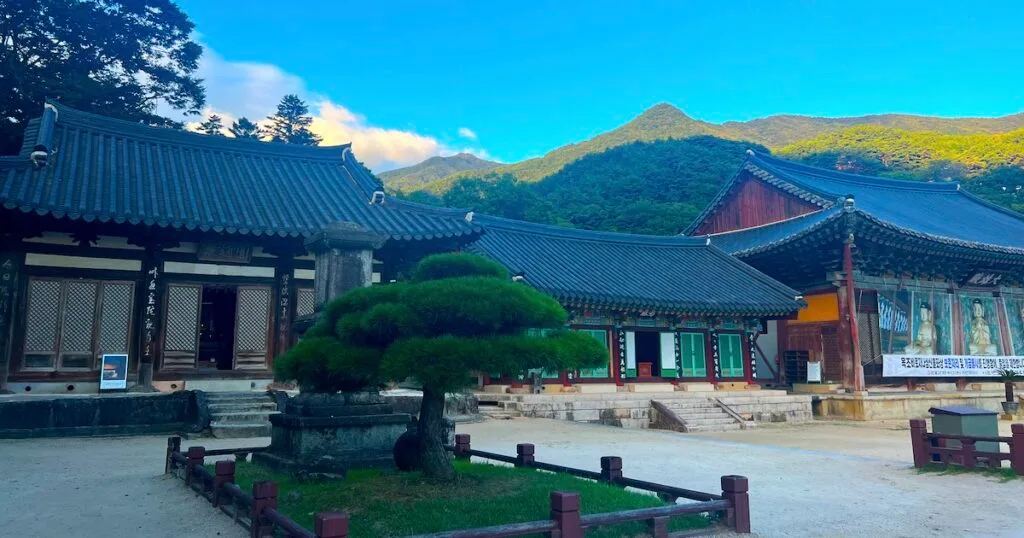
Strolling around the grounds, I was taken aback by the views of the mountains and just how vast the complex was.
There are around 20 buildings set out among manicured grounds, with gorgeous stone statues, lanterns and a three-story pagoda supported by four lion sculptures.
B) Saseongam Temple
Saseongam Temple is on the opposite side of Gurye, high up on Mount Osan and accessible by taxi or car.
It was founded by the same monk, Yeongi, but was built in the 6th century.


This was my favourite temple of the two, mainly because I loved the views down and over Gurye, the Seomgjingang River and the mountains of Jirisan National Park.


Built into the cliff face, the temple has several areas, including a main prayer hall, meditation spaces, caves and a stone Buddha statue.
The temple was a lovely and unexpected addition to my South Korea itinerary.
5. Yeosu
Time needed: 1 Day
Highlights: Cable car, island hikes and wildlife watching
Yeosu is another lesser-known destination that I visited on my South Korea itinerary – the coastal city, whose name translates to ‘beautiful waters’, is part of a peninsula with 365 islands.
Only 48 of those are inhabited.


Here, you can go island-hopping, hiking and kayaking without battling against crowds.
If you want to see as much as possible in one day, you might want to consider booking a one-day private Yeosu tour to visit Manseongri black-sand beach, the Yeosu Cable Car, Odongdo Island and more.
A) Yeosu Cable Car
The main highlight is the Yeosu Cable Car, which hangs above the ocean between Dolsan Park and Jasan Park (at the foot of Yeosu Harbour), overlooking downtown, Dolsandaegyo Bridge and islands.

This is how I came to find out about Yeosu: I came across videos from the cable car on social media.
B) Yeosu Harbour and Odongdo Island
Staying at Utop Marina Hotel & Resort in Yeosu Harbour, I spent most of my time there.
The harbour is the departure point for island-hopping tours and it also has attractions such as the Expo Park, Arte Museum Yeosu and Big-O Show, a light show over the water.

In the harbour is the Sky Tower & Cafe Sky, a popular observation tower.
If you continue south along the promenade, you will eventually reach Odongdo Island, which is connected to the mainland by a 68-metre causeway.
The Camellia Train skips the 15-minute walk to the island, and is a popular activity for kids.
And if you’re ever craving Korean barbecue? I had the most delicious Korean barbecue with beef at Poseogjeong restaurant, which is tucked away down a side street behind Yeosu Harbour.
Alternatively, many of the restaurants in the harbour serve the area’s speciality, marinated raw crab (gejang).
C) Manseongri Beach
Yeosu has a crescent-shaped, black-sand and pebble beach called Manseongri Beach with views of distant islands.
I didn’t get a chance to visit, but you might want to check it out and report back.
D) Take the ferry to islands like Geomundo and Baekdo
From Yeosu Harbour, you can take a ferry to islands like Geomundo and Baekdo.
Baekdo is a nature reserve, and perhaps the best known. This group of rocky, uninhabited islands are home to species like whistling pittas and black pigeons.
The Geomundo islands, inhabited, are more built-up, with walking paths, a lighthouse, trails and an English Cemetery (from its British occupation in the 1880s).
Where to Stay in Yeosu
6. Jeju Island
Time needed: 3 – 5 Days
Highlights: Beaches, hanseyeo (oyster divers), tangerines, and hiking South Korea’s highest mountain
Formed by volcanic eruptions 2 million years ago, Jeju is South Korea’s largest island and is only accessible by plane or ferry.
The main reason I decided to visit Jeju was to climb South Korea’s highest mountain, Mount Hallasan.
However, I also wanted to learn more about the Haenyeo, a collective of all-female free divers who provided food to their families throughout difficult times, such as the Japanese occupation.

With natural pools, waterfalls and beaches, the island has a completely different vibe from the mainland – not to mention a distinct culture and history.
I spent two weeks on Jeju, but you only need a few days to explore the island by bus, tours or private taxi.
A) Hike Mount Hallasan
My one must-do activity on any South Korea itinerary is hiking Mount Hallasan, South Korea’s tallest mountain.
Located at the centre of the island, it has an elevation of 1,947 metres and is considered a sacred place inhabited by gods and spirits.

To hike Mount Hallasan, you need to book your trail using the official online reservation system.
There are two trails to the summit: Seongpanak (the easiest) and Gwaneumsa (the hardest but most scenic).
Most people go up and down Seongpanak. However, I went up Seongpanak and down Gwaneumsa; this meant selecting the Seongpanak trail during sign-up but coming down the alternative, more scenic route.
Going up Seongpanak was easy for me as a regular hiker, but the trail was 90% through the forest with zero views.
Going down Gwaneumsa was hard on the legs and knees. However, the trail was immediately beautiful.


Descending via the Gwaneumsa trail
You need to have a good level of fitness for the Mount Hallasan climb.
B) Explore the east: Seongsan Ilchulbong and the Haenyeo divers demonstration
If you’re wondering which side of the island to explore on your South Korea itinerary, my favourite was the east.
This includes Seongsan Ilchulbong, a small hill formed by hydrovolcanic eruptions around 5,000 years ago.
I hiked for around 20 minutes up to the top of the hill, which has a bowl-like crater 600 metres wide.
It has views back down over the houses, the ocean and volcanic hills rising like dough across Jeju Island.

At the foot of Seongsan Ilchulbong is a black-sand beach, where every day at 2pm, Haenyeo collective members perform a demonstration.
The Haenyeo, whom I read about first in Lisa See’s novel The Island of Sea Women, are a collective of female-only free divers on Jeju.
Haenyeo literally translates to ‘sea women’ and refers to their historical practice of harvesting seafood without the use of oxygen tanks and other gear.

They usually carry equipment like a weighted belt and tewak (a net) to collect their harvest.
Since the 17th century, but particularly in the 18th century, the divers were the main providers for families after many men were lost due to war and taxes.

Note that the Haenyeo demonstration is cancelled during bad weather, which was unfortunately the case when I visited.
I took the bus to the east of the island from Seogwipo, but if you want to make things easier for yourself, you can book onto an east Jeju tour.
These tours also visit Hamdeok Beach, a white-sand beach backed by palm trees and a red lighthouse, and the Jeju Haenyeo Museum. These are harder to reach by bus.
C) Tour the south: waterfalls, natural pools and beaches
As I was based in Seogwipo on the south of Jeju Island, I spent a lot of time exploring the south coast.
My first stop was Cafe Jun, which quickly became my go-to coffee spot on the island. It overlooks Seogwipo Harbour – and the view is truly to die for.


From there, it was just a short stroll to Seogwipo Harbour, lined with traditional fishing boats.
I followed the short hiking trail around Saeseom Island, just over Saeyeongyo Bridge.

Then, I paid a small entry fee to visit the Cheonjiyeon Waterfalls, which is a beautiful but over-commercialised waterfall.

Maybe I’m spoiled from months on the island of Madeira and in Australia, where we had waterfalls to ourselves, and could swim in the natural pools.
I much preferred the Socheonji Natural Pools, a lesser-known spot with natural lava pools.
I walked there directly from Seogwipo, following the route along the Jeju Olle Trail, a network of coastal trails that span the entire island.
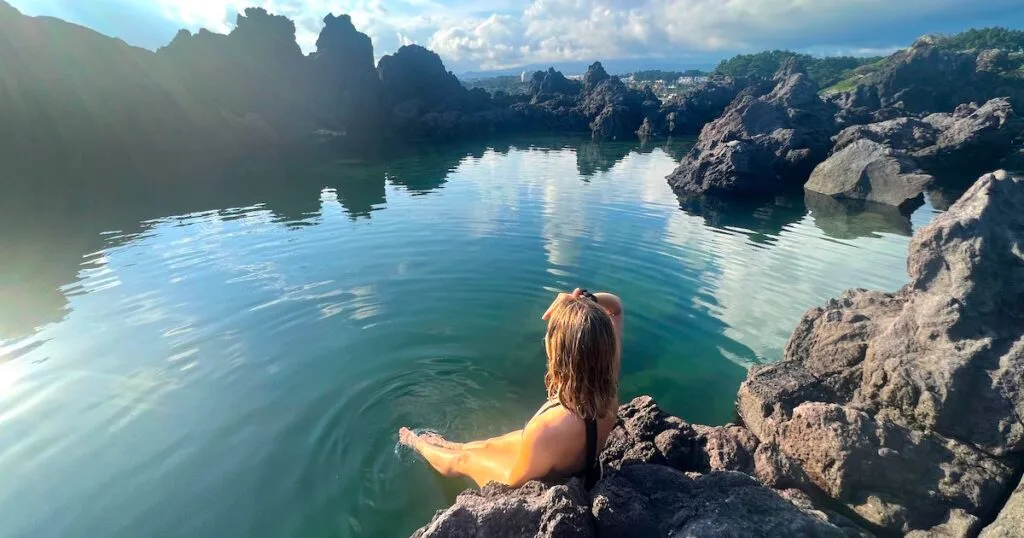
Also on the south coast, I took the bus along to Jungmun Saekdal Beach, a lovely sandy beach backed by a cliff.
It’s popular for surfing, but I spent an afternoon sunbathing instead.
If you book onto a south coast tour, you will usually visit the Cheonjiyeon Waterfall, the O’sulloc Green Tea Museum, Oedolgae and the unique lava tube formations at Jusangjeollidae.
Steal My South Korea Itinerary for 3 – 14 Days
1. How to Spend 3 Days in South Korea
If you only have three days for your South Korea itinerary, I would focus your attention on Seoul.
This large metropolis has historic temples, hiking trails (more scenic than Mount Hallasan, I dare say) and food markets.

It’s also well-connected, so if you fancy taking a day trip to Seoraksan National Park or the DMZ overlooking North Korea, you won’t have any problem doing so.
- Day 1: Spend the day visiting the city’s royal palaces, Gyeongbokgung and Changdeokgung. Then, take a night tour of Gwangjang Market.
- Day 2: Hike Seoul’s highest mountain, Bukhansan. For a lighter day out with good views, you could visit Namsan Mountain Park and Seoul Tower, and while in Myeong-dong, explore the popular shopping district.
- Day 3: Take a DMZ tour, take a day trip to Seoraksan National Park, or book onto a colour and make-up analysis session.
2. South Korea 1-Week Itinerary
One week in Korea gives you more wriggle room to explore outside of Seoul.
After spending a few days in Seoul, you have several options. The most popular route is Seoul (3 days), Busan (2 days) and Jeju (2 days).
However, if you’d like to go off the beaten track, I would replace Busan with Seoraksan National Park.
☀️ 1-Week Itinerary: Seoul, Busan and Jeju
- Day 1 – 3 (Seoul): Follow the Seoul itinerary in the section above.
- Day 4 (Busan): Take an early-morning KTX to Busan to explore Haeundae beach and traditional market, before taking a sunset trip on the Haeundae Blue Line Park Sky Capsule. Optional: visit the Busan X The Sky Observatory (admission ticket here).
- Day 5 (Busan): Visit Gamcheon Cultural Village, Busan Tower and the Jagalchi Fish Market.
- Day 6 (Jeju): Fly to Jeju and check into your accommodation – Seogwipo for Mount Hallasan or the east for sightseeing.
- Day 7 (Jeju): Hike Mount Hallasan, the highest mountain in South Korea, or take an east highlights tour to visit Seongsan Ilchulbong and watch the Haenyeo divers show.
🔥 Unusual 1-Week Itinerary: Seoul, Seoraksan National Park and Jeju
- Day 1 – 2: Spend two days in Seoul, as in the section above.
- Day 3 (Seoraksan National Park): Travel to Seoraksan National Park and spend the evening eating seafood in Sokcho.
- Day 4 (Seoraksan National Park): Hike the Ulsanbawi Rock trail and take the cable car to Mount Seorak.
- Day 5 (Seoul): Take the bus to Seoul and finish any activities you missed.
- Day 6 (Jeju): Fly to Jeju and check into your accommodation.
- Day 7 (Jeju): Hike Mount Hallasan, the highest mountain in South Korea, or take the east highlights tour.
3) 2 Weeks in South Korea Itinerary
If you have two weeks to explore South Korea, you’re in a great position.
You can easily visit every destination in this post – Seoul, Seoraksan, Busan, Yeosu and Jeju Island.
- Day 1 – 3 (Seoul): Explore the city’s temples, climb Bukhansan Mountain and take a tour to the DMZ.
- Day 4-7 (Seoraksan National Park): Spend one full day tackling the Ulsanbawi Rock trail, visit the cable car and see if you can fit in a walk to Biryong Falls.
- Day 7-11 (Busan): After taking the KTX to Busan, explore Haeundae beach and traditional market, visit the Haeundae Blue Line Park Sky Capsule and tick off Gamcheon Cultural Village, Busan Tower and the Jagalchi Fish Market.
- Day 9-11 (Yeosu): See the islands and Dolsandaegyo Bridge from the Yeosu Cable Car, try raw marinated crab and take a wildlife-watching tour to nearby islands.
- Day 11-14 (Jeju): Climb Mount Hallasan, watch the Haenyeo divers show in Seongsan and visit waterfalls or natural pools.
I hope you found my South Korea itinerary useful.
Feel free to leave a comment below to tell me about your time in South Korea – and if you’re looking for more guides to exploring the country, here are some of my other posts.
Suggested reading:

